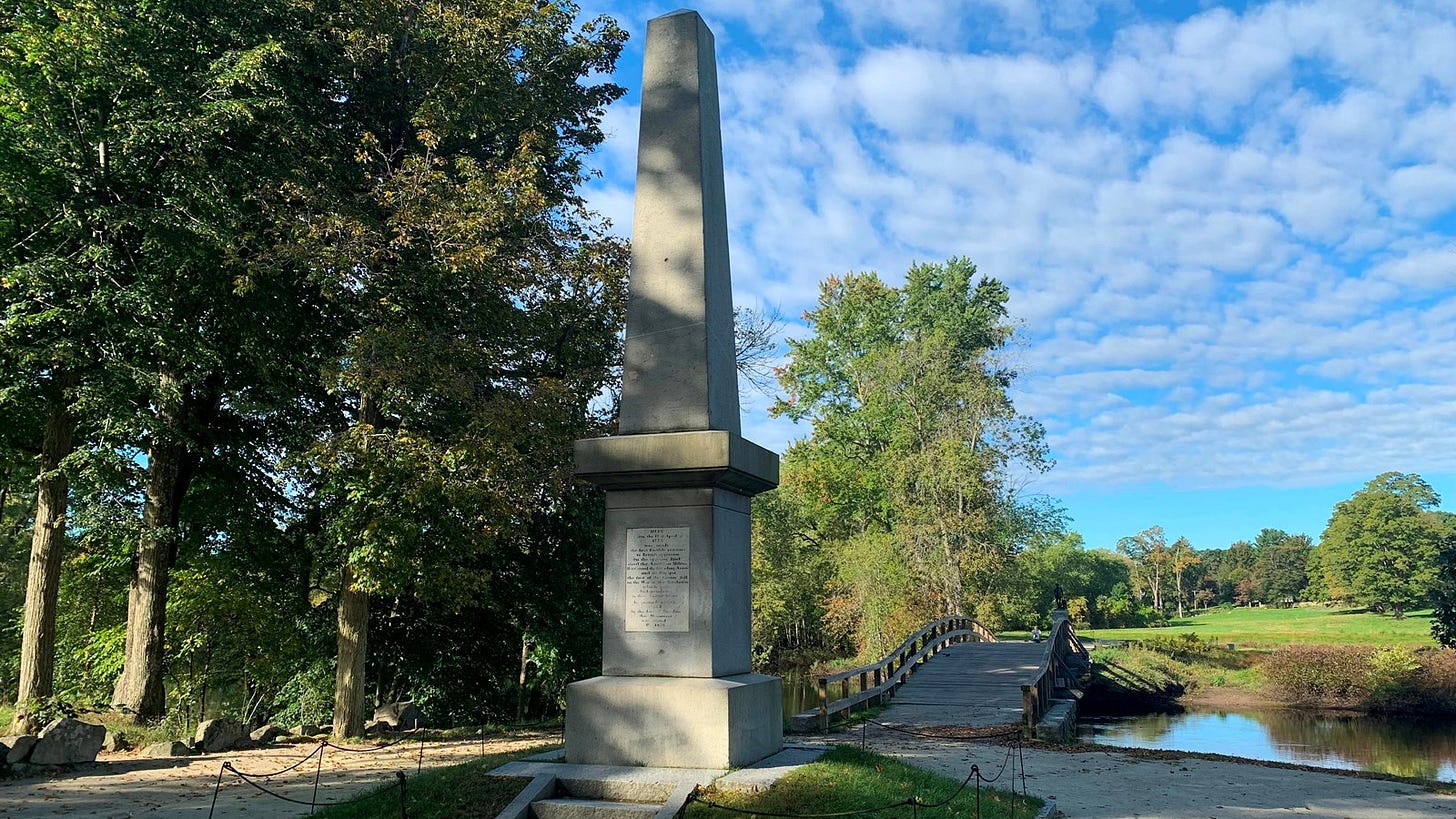Every year in April, the Boston suburb of Lexington reenacts the 1775 Battle of Lexington. Crowds of people start gathering early in the morning (well before 5 a.m.) to watch this—
After a few volleys, smoke devours the battlefield. It’s the smoke that haunts me. I imagine the colonists being fired on by the Redcoats through the smoke on Lexington Common—the musket balls whizzing like comets through the clouds. I think of the men by Concord’s North Bridge a few hours later firing back at the British and winning a surprising victory.
Smoke reigned that morning 250 years ago. In Concord, Major John Buttrick cried “Fire! For God’s sake fire!” in response to volleys from the British. Could he have ever anticipated where that command would lead—to independence, to the Constitution, to the ever-renewed more perfect Union? On that April morning, smoke merged with the mists of dawn.
Ralph Waldo Emerson’s grandfather was at the Battle of Concord, and Emerson wrote a poem for a commemorative obelisk, which was dedicated in 1837:
By the rude bridge that arched the flood, Their flag to April’s breeze unfurled, Here once the embattled farmers stood, And fired the shot heard round the world. The foe long since in silence slept; Alike the conqueror silent sleeps; And Time the ruined bridge has swept Down the dark stream which seaward creeps. On this green bank, by this soft stream, We set to-day a votive stone; That memory may their deed redeem, When, like our sires, our sons are gone. Spirit, that made those heroes dare To die, and leave their children free, Bid Time and Nature gently spare The shaft we raise to them and thee.
“Concord Hymn” isn’t one of Emerson’s best poems (it’s no “Merlin”), nor is it up to the standards of his greatest essays. But “the shot heard round the world” probably has become such a fixture of American rhetoric because it speaks to our infatuation with the way that the small (the tiny shot) can have great consequences.
For our own moment, Emerson’s poem is deeply countercultural. After all, contemporary intellectuals establish their bona fides by disparaging the American regime—not honoring it. During their peak of cultural power, the “woke” elite tried to recast American history as an endless series of wrongs, and the American order was simply an interlocking system of oppression that needed to be deconstructed. Often socialized in the same environments as their “woke” antagonists, a certain “based” vanguard launches their own calumnies against the American order—preferring a secularist techno-monarchy to our inherited liberties.
If it is to have any chance of holding, a Constitutionalist center needs instead to recover the virtues of American history. (It also needs to reject the rigid ideologies that have gutted the establishment and worsened the real challenges facing the United States.) And that recovery demands recognizing how broad the American heritage is. The American Revolution—the battle of Lexington and Concord—is not the inheritance of a few but belongs to all Americans, whatever their background, party, or faith.
The text of Concord’s battle monument is as follows:
HERE on the 19th of April 1775 was made the first forcible resistance to British aggression. On the opposite bank stood the American Militia. Here stood the Invading Army and on this spot the first of the Enemy fell in the War of that Revolution which gave Independence to these United States. In gratitude to GOD and in the love of Freedom this monument was erected AD 1836.
Years later, Concord resident John S. Keyes explained how this inscription was composed by piecing together fragments from various proposed inscriptions:
The committee Col Shattuck, Capt Barrett, Col Wheeler, T. Prescott Esq. Capt Merriam Sted Buttrick & G M Barrett &c asked various leading men to write an inscription, and then attempted to select one from those handed in to them. It was not easy for them to decide, they liked parts of each, but none entirely. Therefore at a meeting at Mr. Prescotts they undertook the task of composing one out of portions of those submitted. ‘Here on the 19th of April 1775,’ was common to nearly all and so was taken it would be hard to say from whose, ‘Was made the first forcible resistance to British aggression’ this from Dr Ripley’s whose controversy with Lexington turned on those very words forcible resistance. On the opposite bank stood the American militia and here the first of the enemy fell,’ was from the lawyer like special pleading of Hon Saml Hoar ‘In the war of that Revolution which gave Independence to these United States’ was from another pen, and the concluding sentence was Mr Emerson’s ‘In gratitude to God and the love of Freedom this monument is erected AD 1836. It was well known and generally understood at the time, how and who composed each part.
“They liked parts of each, but none entirely.” That perhaps is the hope of the American experiment: to be able to fuse together parts in a way that makes a stronger (albeit unexpected) whole. Like the United States itself, our histories are composite.



